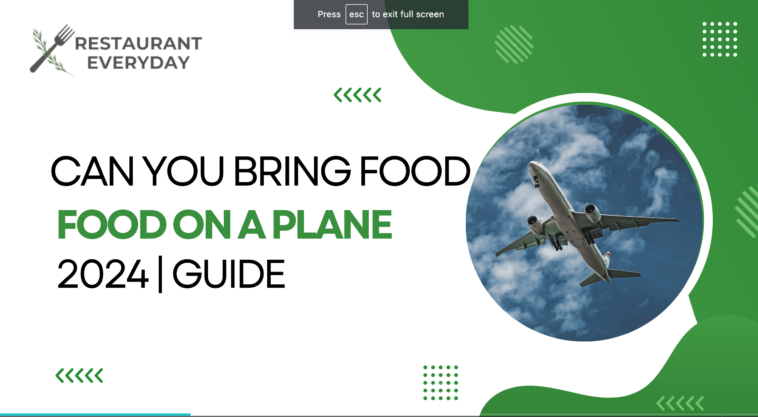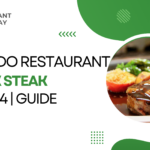Introduction: Can you bring food on a plane
Yes, you can bring food on a plane. Solid food items are generally allowed in both carry-on and checked luggage. However, there are some considerations and guidelines you should keep in mind:
1. Security Check: When carrying food through security, it’s a good idea to pack it in a way that allows easy inspection. Avoid bringing large quantities of liquids or sauces, as these may be subject to the 311 liquids rule.
2. Liquid Restrictions: If you’re carrying liquids, gels, or sauces, make sure each container is 3.4 ounces (100 milliliters) or less and placed in a quart-sized, resealable plastic bag. Each passenger is usually allowed one bag of liquids.
3. Fresh Produce: While fresh fruits and vegetables are generally allowed, you must be aware of agricultural restrictions at your destination. Some countries or regions may have strict rules about importing certain types of fresh produce.
4. Prepackaged Snacks: Prepackaged snacks like granola bars, nuts, and crackers are excellent choices for travel. They are less likely to cause issues during security checks.
5. Hot Food: If you’re carrying hot or freshly cooked food, it’s advisable to pack it in a spillproof container and place it in a well-sealed plastic bag to prevent leaks.
6. Customs Declarations: If crossing international borders, be aware of customs regulations regarding food items. Some countries restrict certain food products to prevent the spread of pests and diseases.
Always check with the airline and relevant authorities for specific guidelines and regulations, as these can vary by country and airline. Additionally, it’s a good idea to consider the duration of your flight and whether the food you’re bringing must be kept at a specific temperature to remain safe for consumption.
Introduction: Understanding airline food policies
Navigating airline food policies is essential to travel preparation, ensuring a seamless journey without any surprises or inconveniences. Whether packing snacks for a short domestic flight or planning meals for a long international journey, understanding airline food regulations is crucial. This guide will explore the general guidelines and considerations to remember when bringing food on a plane.
As passengers, you can bring food onboard, from prepackaged snacks to homemade meals. However, specific rules and restrictions are in place to maintain safety, security, and adherence to international regulations. From security checks to customs declarations, this guide will provide insights into the dos and don’ts, helping you plan your inflight culinary experience.
Join us as we delve into the nuances of airline food policies, offering tips on how to pack and transport your favorite snacks and meals hassle-free. Whether you’re a seasoned traveler or a first-time flyer, this guide aims to empower you with the knowledge needed to navigate the world of airline food regulations confidently. Bon voyage!
TSA guidelines on bringing food:
The Transportation Security Administration (TSA) in the United States has specific guidelines regarding bringing food through airport security. Here are key points to consider:
1. Solid Foods:
Solid foods are generally allowed in both carry-on and checked baggage.
There are no specific restrictions on bringing solid foods through security.
2. Liquids, Gels, and Aerosols:
The 311 liquids rule applies to certain food items. Each passenger can bring liquids, gels, and aerosols in containers of 3.4 ounces (100 milliliters) or less.
These containers must be placed in a quart-sized, transparent, resealable plastic bag, with one bag allowed per passenger.
This rule applies to items like sauces, salad dressings, and beverages.
3. Security Screening:
When packing food items, consider placing them in a way that facilitates security screening. For example, if you bring a lot of snacks, packing them in a way that can be quickly inspected can help streamline the security process.
4. Customs Considerations:
If you are traveling internationally, be aware of customs regulations at your destination. Some countries may have restrictions on certain food items to prevent the introduction of pests or diseases.
5. Special Considerations:
If you carry large quantities of a particular or unusual food item, it may be subject to additional screening.
Always check the most up-to-date guidelines on the official TSA website or contact the airline you are flying with, as rules and regulations may evolve. Additionally, similar restrictions may apply in other countries, so it’s essential to familiarize yourself with the specific guidelines of the airports and countries you will be traveling to and from.
Packing tips for carrying food on flights:
Packing food for flights requires some consideration to ensure your items remain fresh, secure, and comply with airline regulations. Here are some tips for packing food when traveling by air:
1. Check Airline Policies:
Review the specific food-related policies of the airline you are flying with. Different airlines may have slightly different rules or restrictions.
2. Consider the Duration of the Flight:
For short flights, nonperishable snacks and prepackaged items work well. Consider bringing more substantial and perishable items for longer flights, especially those without meal services.
3. Use Sealable Containers:
Pack food in sturdy, leakproof containers to prevent spills and keep the food fresh. Consider using containers with tight-fitting lids for items like salads, fruits, or anything with sauces.
4. Avoid Liquids:
Minimize the amount of liquid in your food items to comply with the 311 liquids rule. If you must bring liquids, ensure they are in containers of 3.4 ounces (100 milliliters) or less and placed in a quart-sized, resealable plastic bag.
5. Pack in Layers:
If you have a variety of snacks or items, pack them in layers within your carry-on bag. This makes it easier for security to inspect if needed.
6. Consider ShelfStable Options:
Opt for foods that are less perishable and can withstand temperature variations. Nuts, dried fruits, granola bars, and prepackaged snacks are good choices.
7. Bring Utensils:
If your meal requires utensils, pack disposable ones to avoid any inconvenience. Airlines may provide utensils for their meals, but having your own ensures you’re prepared.
8. Use Insulated Bags or Containers:
If you’re carrying perishable items that need to be kept cool, use insulated bags or containers with ice packs. Make sure to check if the ice packs comply with airline regulations.
9. Be Mindful of Odors:
Avoid packing strong-smelling foods to be considerate of fellow passengers. Opt for items that won’t produce strong odors during the flight.
10. Customs Considerations:
If traveling internationally, be aware of customs regulations regarding food items at your destination. Some countries have strict rules to prevent the introduction of certain foods.
Remember to be mindful of the quantity of food you’re bringing, as excess may be subject to additional scrutiny. Always check with the airline and relevant authorities for the most up-to-date information and guidelines.
Allergies and dietary restrictions while flying:
Traveling with allergies or dietary restrictions requires careful planning to ensure a safe and comfortable journey. Here are some tips to consider:
1. Inform the Airline in Advance:
Most airlines allow passengers to inform them about dietary restrictions and allergies when booking tickets. Contact the airline’s customer service in advance to discuss your specific needs.
2. Request Special Meals:
Many airlines offer special meals to accommodate various dietary requirements, including vegetarian, vegan, gluten-free, or allergy-friendly options. Request these meals at the time of booking or well in advance of your flight.
3. Bring Snacks:
Pack safe and nonperishable snacks that align with your dietary needs. This is particularly important if the airline’s food options still need to meet your requirements fully.
4. Read Labels:
If you’re bringing your food, ensure that packaged items have clear ingredient labels and be vigilant about potential allergens.
5. Avoid Airplane Food If Necessary:
You may avoid airline food altogether and rely on your snacks and meals if you have severe allergies. Check with the airline about their policies regarding bringing your food.
6. Medication and Documentation:
Carry any necessary medication for severe allergies, such as an epinephrine autoinjector. Also, have relevant medical documentation (e.g., a doctor’s note) that outlines your dietary restrictions or the need for certain medications.
7. Wipe Down Surfaces:
Bring sanitizing wipes to clean your immediate surroundings, including tray tables and armrests, to reduce the risk of allergen exposure.
8. Notify Cabin Crew:
Once you board the flight, inform the cabin crew about your allergies or dietary restrictions. They can provide additional assistance and alert you to potential concerns.
9. Choose NonPeanut Flights:
Some airlines may offer flights with reduced or no peanut products to accommodate passengers with severe peanut allergies. Check with the airline to see if this option is available.
10. Research Airline Policies:
Familiarize yourself with the specific policies of the airline you’re flying with regarding allergies and dietary restrictions. Some airlines may have more comprehensive services for accommodating passengers with special dietary needs.
Always check the airline’s website or contact their customer service for the most up-to-date and accurate information regarding their allergies and dietary restrictions policies. Being proactive and well-prepared can contribute to a smoother and safer travel experience.
Conclusion: can you bring food on a plane:
In conclusion, yes, you can bring food on a plane. Whether on a short domestic flight or a long international journey, passengers can generally carry food items in carry-on and checked luggage. However, it’s essential to be mindful of specific guidelines and considerations:
1. Security Checks: Pack food in a way that facilitates easy inspection during security checks. Avoid bringing large quantities of liquids, and adhere to the 311 liquids rule for containers exceeding 3.4 ounces (100 milliliters).
2. Solid Foods: Solid foods are generally permitted. Prepackaged snacks, sandwiches, and other nonliquid items are convenient options for travel.
3. Liquids and Gels: If carrying liquids, such as sauces or dressings, ensure they comply with the 311 liquids rule and are packed in a quart-sized, resealable plastic bag.
4. Fresh Produce: While fresh fruits and vegetables are allowed, be aware of agricultural restrictions at your destination, especially when traveling internationally.
5. Customs Declarations: Consider customs regulations at your destination, as some countries may have specific restrictions on certain food items.
6. Packaging and Containers: Use sealable, leakproof containers to prevent spills and keep food fresh. Insulated bags or containers are advisable for perishable items.
7. Consideration for Fellow Passengers: Avoid bringing strong-smelling foods and be mindful of fellow passengers, especially in confined spaces.
Remember to check with the airline and relevant authorities for updated guidelines, as regulations can vary. With proper planning and policy adherence, bringing food on a plane can enhance your travel experience by providing familiar and enjoyable meal options.




